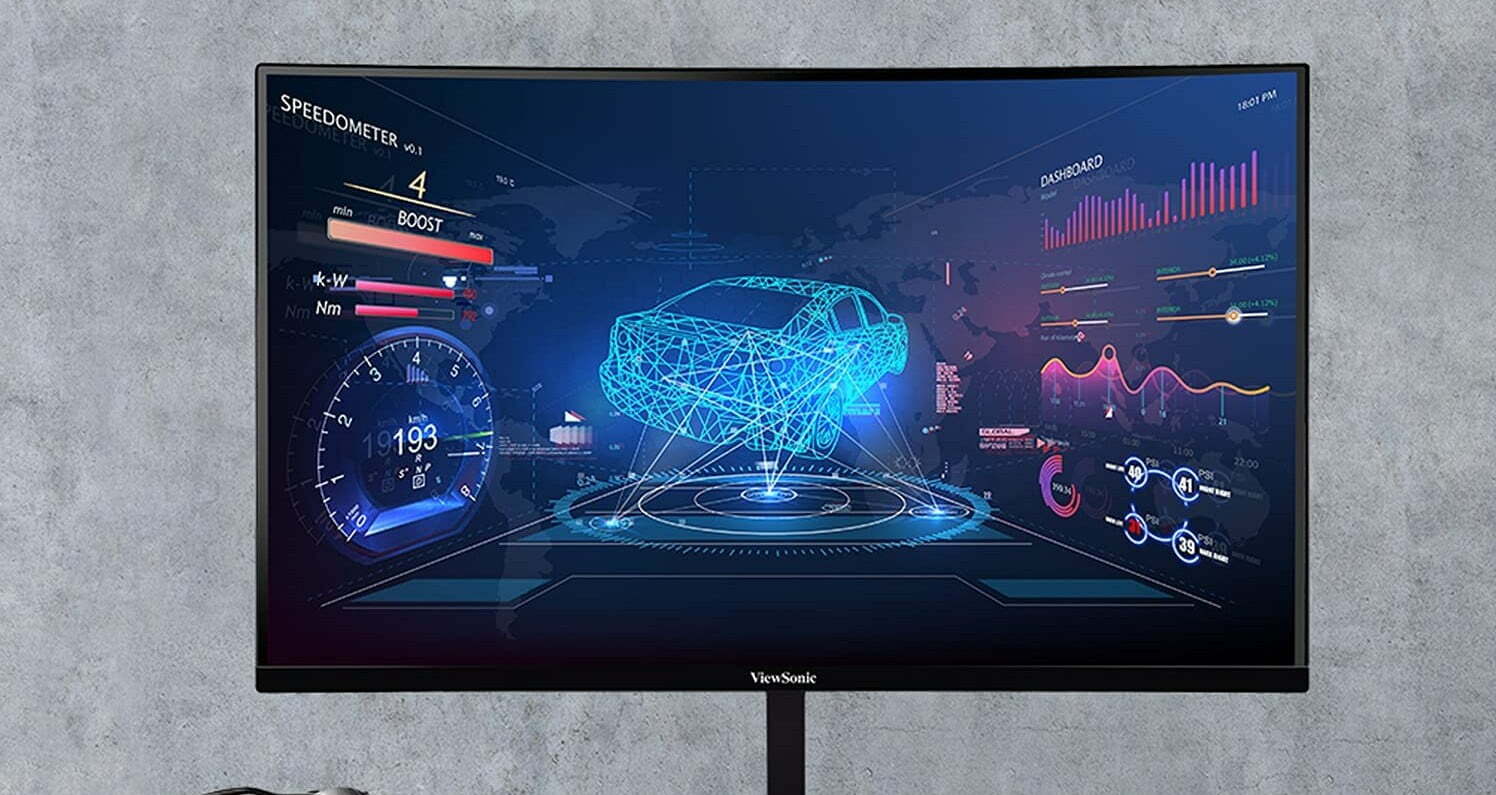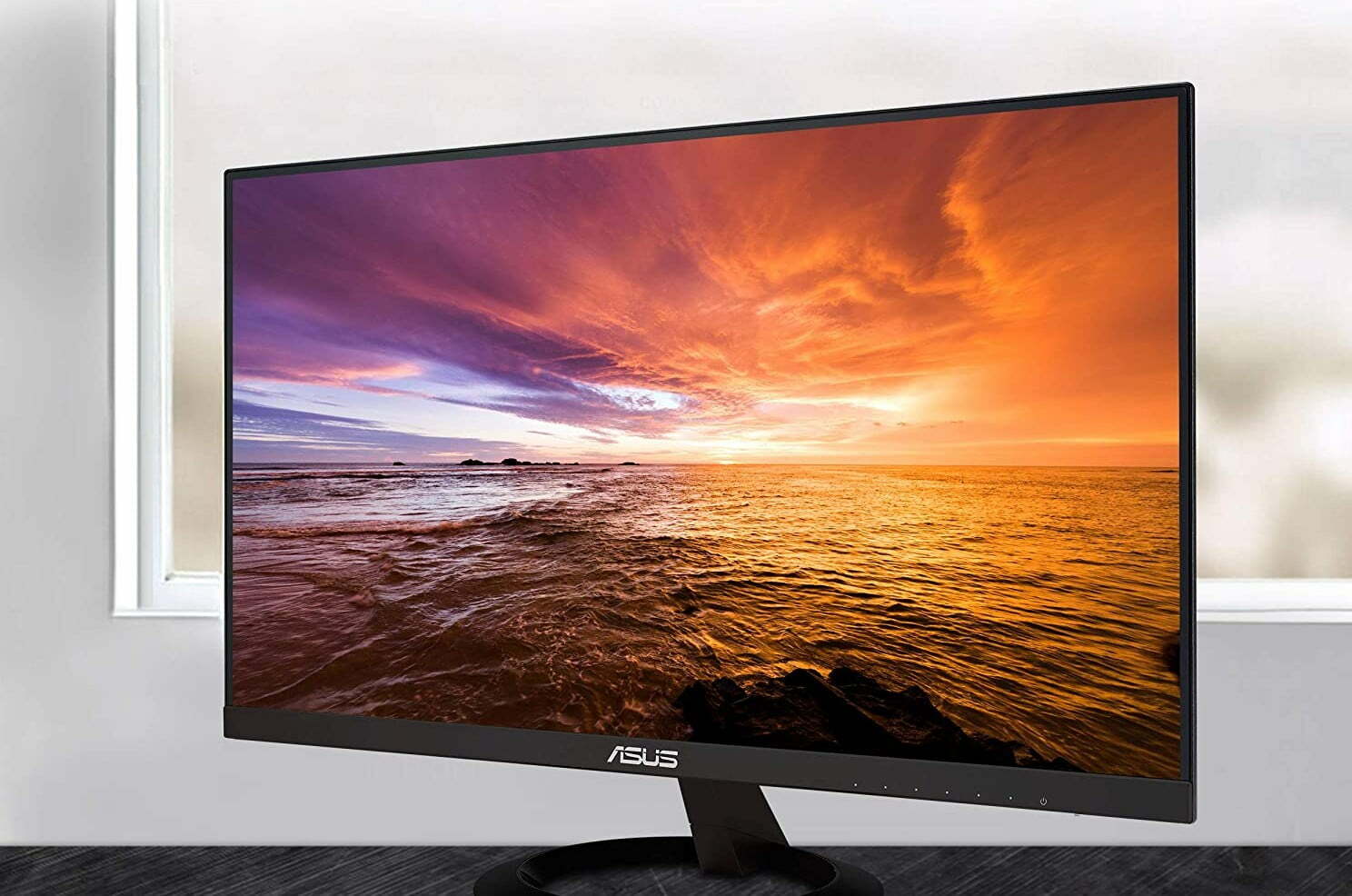Key Takeaways:
- A downward angle of about 15 degrees below the viewer’s eye line is optimal for maximum comfort, eye strain reduction, viewing range, and prevention of involuntary head tilt.
- Viewing distances of no less than 20″ from the viewer to the display will further prevent eye strain and increase productivity and energy.
- Begin your monitor positioning by tilting the monitor down 15 degrees to start with a slightly downcast angle to your eye line.
Defining Viewing Angle
Anyone who works for hours every day in an office or a home office in front of a computer screen knows that it can take its toll physically, especially if you don’t have the right monitor panel type. Eye strain, neck strain, back, and leg pain are all serious issues and all can result from poor ergonomics when it comes to seating position and a monitor’s viewing angle- the latter of which we’re concerned with here. Keep reading to see why your monitor’s viewing angle matters and how to adjust it for the healthiest, most comfortable work experience possible.
Related Posts:
Monitor Viewing Angle
Extensive research has been done in recent years regarding computer workstation ergonomics, and though results have varied slightly from study to study regarding optimal viewing angle for displays and high-end monitors.
The general consensus, however, is that at a position of rest, the eyes should naturally assume a straight but slightly downcast line of sight. The degree to which the eyes should be downcast for optimal strain resistance and comfort is between 15 and 30 degrees.
This means that the best vertical position for your monitor should be at about 15 degrees below the horizontal eye line, creating a visual zone of 30 degrees- that’s 15 degrees above and below the horizontal eye line.
There’s some wiggle room beyond that since while field studies have concluded that viewing your screen upwards for extended periods of time is tiring to the eyes, they’ve also found even a lower range 30 degrees past the horizontal eye line is acceptable for most work for medium periods of time (a short workday, for example), bringing the total acceptable viewing range to 45 degrees.
Following these numbers as a rule of thumb should eliminate most of the danger of severe eye strain for an average work period of 8 hours. Moreover, having the right type of display can also reduce eye strain. Learn more about quantum dot monitors, and how they’re able to improve eye strain. Once you’ve achieved the optimal viewing angle, you’re ready to use your monitor in a healthy and efficient way, whether that be for work or gaming. You may also own gaming consoles you’d want to connect to your monitor, and we have guides on how to do so, in case you’re asking yourself something like “Can you connect a Wii to a monitor?”
Related Posts:
A Word About Head Tilting
It’s important to keep in mind when discussing ideal monitor viewing angle that the above numbers refer to eye line and visual range without head tilt taken into consideration.
Research has shown that head tilt can add considerable strain to the spine during long periods of work, even at minimal angles. A head tilt angle of as little as 15 degrees up or down adds almost 30 pounds of pressure to the spine.
Thankfully, if you’ve adjusted your viewing angle properly, you’ll have a good visual range vertically and horizontally without having to tilt your head at all though mindfulness during work is important since the body can adjust itself involuntarily and you can find yourself forming bad viewing habits.
To that end, it’s a good practice to always start off positioning your monitor by angling it downwards, if possible via a swivel or wall mount.
STAT:
Recommended viewing distance for average-sized computer monitors (under 30″) is no less than 20″
https://www.ergotron.com/en-us/ergonomics/ergonomic-equation#:~:text=Your%20eyes%20should%20look%20slightly,larger%2C%20add%20more%20viewing%20distance.
Ideal view distance from large-format displays (30″ or more) is 3.5″- 5.5″
https://www.ccohs.ca/oshanswers/ergonomics/office/monitor_positioning.html
Head tilt of as little as 15 degrees can cause considerable spinal strain over long work hours
*https://www.viewsonic.com/library/entertainment/monitor-curvature-explained/
Sources:
https://www.ccohs.ca/oshanswers/ergonomics/office/monitor_positioning.html
*https://www.viewsonic.com/library/business/best-computer-screen-positioning/
https://www.glfw.org/docs/3.3/monitor_guide.html
https://www.joeedelman.com/monitor-viewing-angle-gauge/




































![Best 27 Inch Computer Monitor in [year] 27 Best 27 Inch Computer Monitor in 2026](https://www.gadgetreview.dev/wp-content/uploads/how-to-buy-the-best-computer-monitor.jpg)
![Best BenQ Monitors in [year] 28 Best BenQ Monitors in 2026](https://www.gadgetreview.dev/wp-content/uploads/best-benq-monitor-image.jpg)
![Best ASUS Monitors in [year] 29 Best ASUS Monitors in 2026](https://www.gadgetreview.dev/wp-content/uploads/best-asus-monitor-image.jpg)
![Best Dell Monitors in [year] 30 Best Dell Monitors in 2026](https://www.gadgetreview.dev/wp-content/uploads/best-dell-monitor-image.jpg)
![Best HP Monitors in [year] 31 Best HP Monitors in 2026](https://www.gadgetreview.dev/wp-content/uploads/best-hp-monitor-image.jpg)
![Best Lenovo Monitors in [year] 32 Best Lenovo Monitors in 2026](https://www.gadgetreview.dev/wp-content/uploads/best-lenovo-monitor-image.jpg)
![Best ViewSonic Monitors in [year] 33 Best ViewSonic Monitors in 2026](https://www.gadgetreview.dev/wp-content/uploads/best-viewsonic-monitor-image.jpg)
![Best Gigabyte Monitors in [year] 34 Best Gigabyte Monitors in 2026](https://www.gadgetreview.dev/wp-content/uploads/best-gigabyte-monitor-image.jpg)
![Best Monitors for PS4 Pro Gaming in [year] 35 Best Monitors for PS4 Pro Gaming in 2026](https://www.gadgetreview.dev/wp-content/uploads/best-monitors-for-ps4-pro-image.jpg)
![Best Monitor for Xbox Series X in [year] 36 Best Monitor for Xbox Series X in 2026](https://www.gadgetreview.dev/wp-content/uploads/best-monitor-for-xbox-series-x-image.jpg)
![Best Acer Monitors in [year] 37 Best Acer Monitors in 2026](https://www.gadgetreview.dev/wp-content/uploads/best-acer-monitor-image.jpg)
![Best MSI Monitors in [year] 38 Best MSI Monitors in 2026](https://www.gadgetreview.dev/wp-content/uploads/best-msi-monitor-image.jpg)
![Best SAMSUNG Monitors in [year] 39 Best SAMSUNG Monitors in 2026](https://www.gadgetreview.dev/wp-content/uploads/best-samsung-monitor-image.jpg)
![Best LG Monitors in [year] 40 Best LG Monitors in 2026](https://www.gadgetreview.dev/wp-content/uploads/best-lg-monitor-image.jpg)
![Best AOC Monitors in [year] 41 Best AOC Monitors in 2026](https://www.gadgetreview.dev/wp-content/uploads/best-aoc-monitor-image.jpg)
![Best Philips Monitors in [year] 42 Best Philips Monitors in 2026](https://www.gadgetreview.dev/wp-content/uploads/best-philips-monitors-image.jpg)
![Best Monitors For PUBG in [year] 43 Best Monitors For PUBG in 2026](https://www.gadgetreview.dev/wp-content/uploads/best-monitor-for-pubg-image.jpg)
![Best Stream Decks in [year] 44 Best Stream Decks in 2026](https://www.gadgetreview.dev/wp-content/uploads/best-stream-deck-image.jpg)
![Best Monitors for Streaming in [year] 45 Best Monitors for Streaming in 2026](https://www.gadgetreview.dev/wp-content/uploads/best-monitor-for-streaming-image.jpg)
![Best Monitors For Flight Simulator in [year] 46 Best Monitors For Flight Simulator in 2026](https://www.gadgetreview.dev/wp-content/uploads/best-monitor-for-flight-simulator-image.jpg)




















